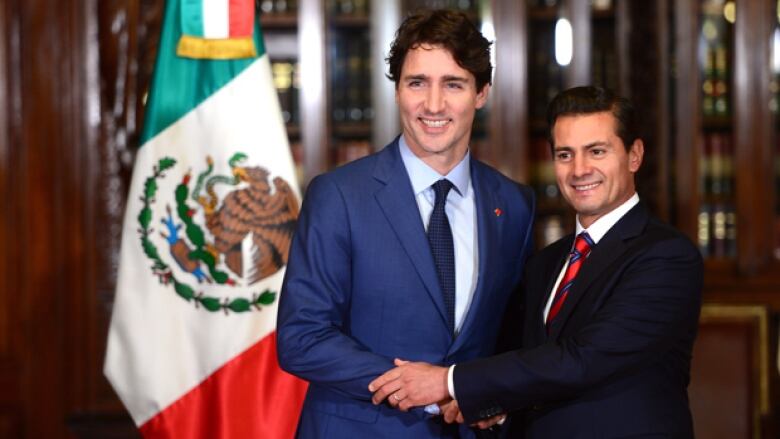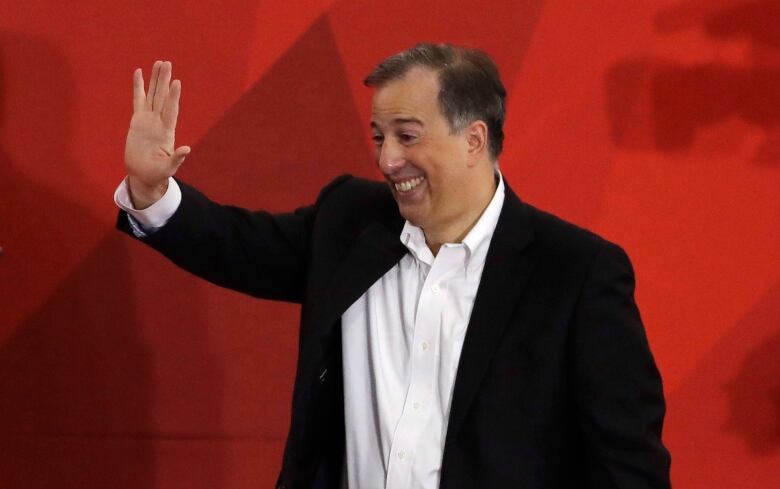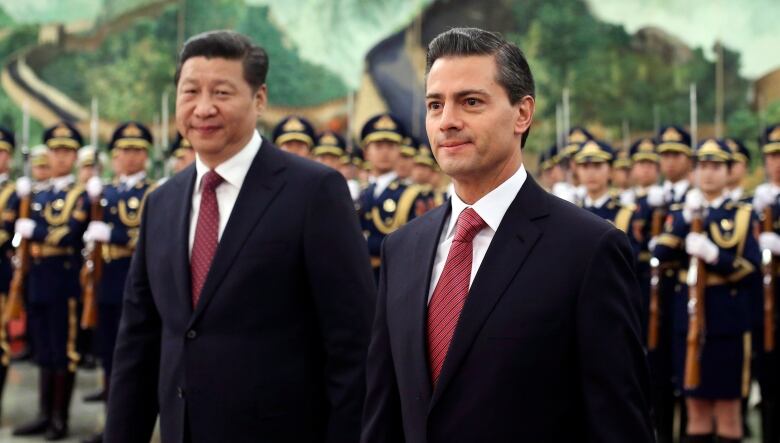Rising pessimism has Mexico exploring world of post-NAFTA possibilities
Trudeau has said Canada doesn't need a Plan B. Mexico seems less convinced NAFTA talks will succeed

"There is no need for a Plan B," Prime Minister Justin Trudeau said in June,when asked what Canada would do if NAFTA renegotiations failed.
Canada, Trudeau told theNew York Times, was confident the free trade deal could be salvaged.
That is Mexico's preferred option as well, but fears the Trump administration in the U.S. will end the accordare driving new thinking about trade as Mexico enters its 2018 presidential campaign in a changed political landscape.
The government of Enrique Pena Nieto might already be implementing a Plan B of sorts as it triesto sign as many trade deals as possible to replace the country that buys 80 per cent of its exports.

An unlikely new right-left coalition has emerged to challenge the incumbent Institutional Revolutionary Party(PRI), and to stop left-wing firebrand Andres Manuel Lopez Obrador. Some of the coalition's members are pushing a Plan C that would lead to the elimination of all tariffs in an effort to turn Mexico into a Latin Singapore.
Mexico is also drawing closer to China, hoping to send a message to the U.S. that its southern neighbour has other dance partners.
Stay the course
Jose Antonio Meade quit as Mexico's finance minister last month to focus on his campaign to succeed President Enrique Pena Nieto as standard-bearer of the PRI in the July 1 election.
If Meade wins, Mexico would likely continue the policies of Pena Nieto.
If he loses, it might do the same anyway.
Before the rise of Trump, Mexico's business community generally assumed the main threat to NAFTA came from within, courtesy of Lopez Obrador. But he's cooled his anti-trade rhetoric of late, and now acknowledges that 23 years of free trade have been net-positive for Mexico.
His election might make it more difficult to make concessions to save NAFTA, but would not lead automatically to a Mexican pullout.

Mexico's other major left-wing party, the Party of the Democratic Revolution (PRD), last week formed a coalition with the centre-right National Action Party (PAN).
It's widely assumed the coalition's candidate will be PAN's Ricardo Anaya, and that the coalition will adopt PAN's pro-NAFTA platform.
So today, the only credible threat to NAFTA comes from outside Mexico, courtesy of U.S. President Donald Trump. Or as the Mexicans call him,"el loco del norte."
Plan B, C, D
The Mexican government has followed some of the same steps as the Trudeau government touring China, talking to the European Union but unlike Canada, which has pledged not to walk away fromNAFTA negotiations, Mexico saysit may.
"If the conditions aren't there, it's better to get out of the free trade deal and adapt to the rules established by the World Trade Organization," Ernesto Cordero, president of Mexico's Senate, has said.
If NAFTAwere to end, the terms of trade between the U.S. and Mexico would be the tariffs fixed under the WTO.
Mexico has had some success at finding new markets. In the first half of this year, the proportion of its exports that go to the U.S. fell slightly, largely because exports to Japan, Brazil and the EU grew by 11.3 per cent, 13.5 per cent and 13.7 per cent, respectively. Exports to Canada also grew by 6.2 per cent.

Alejandro Luna, a trade lawyer with the large Mexico City firm of SantamarinaandSteta, says he and others have called for greater trade diversification over the years, but the threat to NAFTA seems to have helped produce results.
"The renegotiation finally opened our eyes."
Mexico's trade negotiatorsare in talks with the EU to modernize a 20-year-old free trade agreement. They're also having discussionswith Brazil and Argentina,and with the European Free Trade Area of Norway, Switzerland, Iceland and Liechtenstein.
Mexico is lookingto buy more corn from Argentina and Brazil as part of a conscious effort to give the U.S. a taste of the pain its farmers could expect if NAFTA ends.
"Diversification is coming about," Luna said. "But it will take some years, and even then, the U.S., and to an extent Canada, will still be our predominant trade partners."
China to the rescue?
Mexico sent its first shipment of blueberries to China last summer, as trade between the two countries continues to grow.
But experts are skeptical the Chinese market can solve Mexico's trade issues should the NAFTA talks fail.
"It's become very sexy to talk about replacing trade with the U.S. with trade with China," said Enrique Dussel Peters, an economist at the Universidad Nacional Autonoma de Mexicoand co-ordinator of its Centre for Mexico-China Studies. "It's as if one could simply start sending to China, automatically and massively, the same cars we now send to North America.
"Anyone who's ever been involved in a company or a production chain knows it just isn't so."

In fact, Mexico's trade with China is even more unbalanced than America's, he said.
"They sell us 14 times as many goods as we sell them."
He saidMexico's best options outside of NAFTA lie in modernizing and making more use of its free trade agreements with more than 40 countries and blocs worldwide.
Doors wide open
One of the more radical trade proposals floating around Mexico City involves turning the country into a tariff-free zone.
Senator Francisco Burquez Valenzuela of PAN says that if the U.S. closes itself off, Mexico should respond by making itself more open.
He's proposed a five-year transition to a regime of totally free trade, aimed at lowering prices for Mexican consumers and cutting costs for Mexican manufacturers.
Dussel Peters says the plan is "completely unrealistic" and would actually decimate entire sectors of Mexican manufacturing.
But it shows the kind of thinking that's occurring in a country where there's less optimism about NAFTA's survival than there is in Canada.
Trade lawyer Alejandro Luna says Mexico has been encouraged by Canadian support, particularly during Trudeau's recent trip to Mexico City, which calmed fears that Mexico would be thrown under the bus by its NAFTA partners.
"We do feel that we have an ally in this negotiation. We recognize that each side will have its own interests and needs, but we feel that we can count on Canada to back up the NAFTA agreement as a whole."
Dussel Peters says Mexican industry is also coming to the realization that the end of NAFTA wouldn't mean the end of trade with the U.S. Supply chains are too integrated and the investments are too big to be dismantled just because tariffs tick up a few points.
"The real Plan B after NAFTA," he said, "is to keep on trading with the U.S. and Canada, but to do it without NAFTA."












_(720p).jpg)


 OFFICIAL HD MUSIC VIDEO.jpg)
.jpg)



























































































